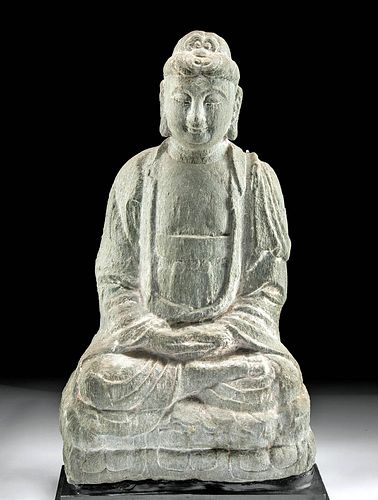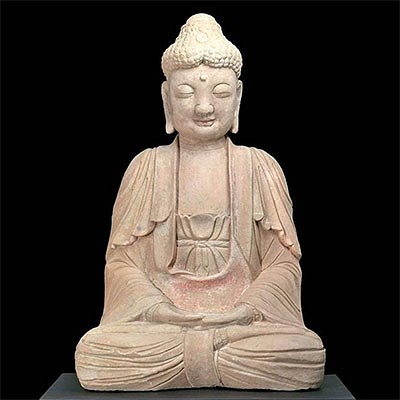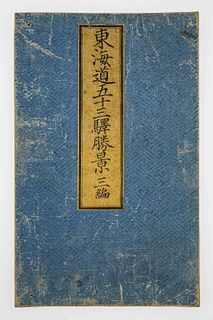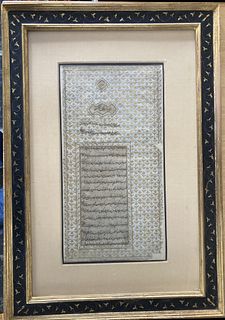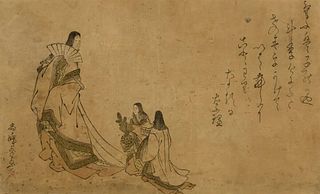Chinese Tang Dynasty Stone Buddha Shakyamuni Statue
Lot 79a
About Seller
Artemis Fine Arts
686 S Taylor Ave, Ste 106
Louisville, CO 80027
United States
Selling antiquities, ancient and ethnographic art online since 1993, Artemis Gallery specializes in Classical Antiquities (Egyptian, Greek, Roman, Near Eastern), Asian, Pre-Columbian, African / Tribal / Oceanographic art. Our extensive inventory includes pottery, stone, metal, wood, glass and textil...Read more
Categories
Estimate:
$15,000 - $37,500
Absentee vs Live bid
Two ways to bid:
- Leave a max absentee bid and the platform will bid on your behalf up to your maximum bid during the live auction.
- Bid live during the auction and your bids will be submitted real-time to the auctioneer.
Bid Increments
| Price | Bid Increment |
|---|---|
| $0 | $25 |
| $300 | $50 |
| $1,000 | $100 |
| $2,000 | $250 |
| $5,000 | $500 |
| $10,000 | $1,000 |
| $20,000 | $2,500 |
| $50,000 | $5,000 |
| $100,000 | $10,000 |
| $200,000 | $20,000 |
About Auction
By Artemis Fine Arts
Feb 18, 2021
Set Reminder
2021-02-18 10:00:00
2021-02-18 10:00:00
America/New_York
Bidsquare
Bidsquare : Exceptional Antiquities, Asian, Ethnographic
https://www.bidsquare.com/auctions/artemis-gallery/exceptional-antiquities-asian-ethnographic-6373
Museum-worthy examples of Egyptian, Greek, Roman, Etruscan, Near Eastern, Far East / Asian, Pre-Columbian, African / Tribal, Oceanic, Native American, Spanish Colonial, Russian, Fossils, Ancient Jewelry, Fine Art, so much more! Artemis Fine Arts info@artemisfinearts.com
Museum-worthy examples of Egyptian, Greek, Roman, Etruscan, Near Eastern, Far East / Asian, Pre-Columbian, African / Tribal, Oceanic, Native American, Spanish Colonial, Russian, Fossils, Ancient Jewelry, Fine Art, so much more! Artemis Fine Arts info@artemisfinearts.com
- Lot Description
East Asia, China, Tang Dynasty, ca. 618 to 907 CE. A finely carved and impressively sizeable, stone Buddha (Shakyamuni, the Enlightened form), traditionally robed and seated in full lotus position atop a double lotus throne pedestal, displaying the dhyana mudra with both hands placed in his lap, palms facing upwards. This gesture of meditation is consonant with his contemplative peaceful visage comprised of downcast eyes, an elegant nose, pursed lips, an urna (circular dot on the forehead) that serves as an auspicious mark symbolizing the third eye which extrapolates to keen vision into the divine world as well as the ability to look past suffering, and characteristically elongated ears - all topped by one of the most elegant topknots we have seen, finely delineated with a symmetrical arrangement of wavy tresses and curls. Size: 14.875" W x 27.75" H (37.8 cm x 70.5 cm); 29.75" H (75.6 cm) on included custom stand.
Buddha's robes are skillfully rendered, draped in a naturalistic way, while his facial features are serene and lifelike. He presents an overall peaceful countenance with the body engaged in meditation and the visage presenting a rounded ushnisha symbolizing the wisdom and knowledge acquired after attaining enlightenment, as well as elongated ears, a physical feature symbolic of the Buddha's time as a prince when he wore elaborate ear ornaments to demonstrate wealth and prosperity. Of course, the prince stopped wearing them when he left the palace to become an ascetic; however, his earlobes remained stretched signifying a conscious decision to reject the material world in exchange for spiritual enlightenment and simultaneously suggest that the Buddha can hear all that is asked for and needed in the earthly world. Those half-closed eyes indicate a meditative state - at once looking both outward and inward. Furthermore, the curled hair of the Buddha signifies the nobility of Buddha. Beyond the multi-layered meaning embodied in the iconography of this piece, the sculptor's artistry and technique are exceptional.
Provenance: private Hawaii USA collection; ex Micky Micklautz collection, Honolulu, Hawaii USA, 1945 to 1990
All items legal to buy/sell under U.S. Statute covering cultural patrimony Code 2600, CHAPTER 14, and are guaranteed to be as described or your money back.
A Certificate of Authenticity will accompany all winning bids.
We ship worldwide and handle all shipping in-house for your convenience.
#108936Expected surface wear with some chips to high-pointed areas and areas of abrasion commensurate with age. Scattered deposits grace the surface as well.Condition
- Shipping Info
-
All shipping is handled in-house for your convenience. Your invoice from Artemis Gallery will include shipping calculation instructions. If in doubt, please inquire BEFORE bidding for estimated shipping costs for individual items.
-
- Buyer's Premium



 EUR
EUR CAD
CAD AUD
AUD GBP
GBP MXN
MXN HKD
HKD CNY
CNY MYR
MYR SEK
SEK SGD
SGD CHF
CHF THB
THB